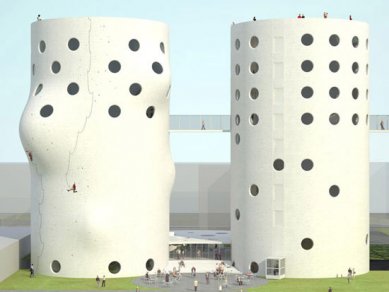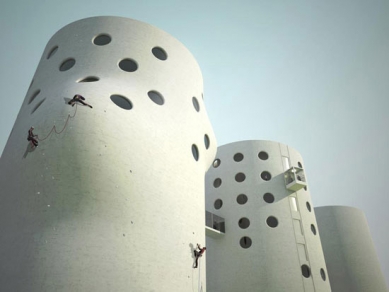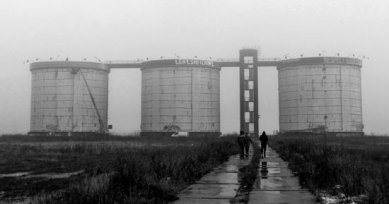
Soutěžní návrh lezeckého centra v Amsterdamu od NL architects
V dubnu minulého roku vyhlásila amsterodamská radnice soutěž na přestavbu dvou opuštěných sil ve čtvrti Zeeburg. Ze zásobníků na splašky by mělo podle vítězného projektu od Arons en Gelauff Architecten vzniknout nové víceúčelové kulturní centrum pojmenované podle slavné holandské autorky dětských knížek Annie MG Schmidt.
Mezi řadou neoceněných projektů byl také návrh NL Architects, který se rozhodl bývalá sila věnovat horolezectví, sportu a kultuře. Kvůli lepšímu výhledu do okolní krajiny jejich návrh prodlužuje válcovitou hmotu sil do maximální povolené výšky. Kulturní silo tvoří dva divadelní sály se šatnami a zkušebnami, dílnami, výstavními prostory, hudebními studii a kadeřnickým studiem. Lávka spojující obě sila ve původní výšce stavby nyní obsahuje kancelářské místnosti. Na samém vrcholu budou restaurace s panoramatickým výhledem a střešní terasa.
Válcovitá hmota sil posloužila jako základ pro 40 metrů vysokou umělou lezeckou stěnu, která obsahuje i několik obtížných míst s převisy. Poněvadž jsou lezecké stěny nakloněny dovnitř, vzniká směrem vzhůru postupně kolem lezeckého komínu stále více využitelné plochy. V horních podlažích je hotel, výukové prostory a veřejné náměstí, které lze využívat různými způsoby. V přízemí se nachází kavárna, která je s lezeckou stěnou opticky spojena dírou ve stropě a okolní stěny kavárny jsou obloženy tréninkovými bouldery. Lezecké chyty jsou namontovány také na obvodovém plášti zvenku. Fasádu kulturního centra budou oživovat horolezci zdolávající venkovní lezeckou stěnu.
Rebirth of the Silos
‘The silos on Zeeburgereiland are looking for a new destination. The relocation of the sewage treatment plant sparked new developements in the area: the island now becomes inhabitable. It is strategically positioned in between the center of Amsterdam and its latest expansion called IJburg. The island is very accessible; it directly links to the ring road A10.
Three silos will remain. One will be developed into an office building and is not part of the competition. But it is essential that the tower will be conceived in close cooperation with the two other silos; they should form a set. In this proposal the silos will be dedicated to climbing, sports and culture. The Second Coming of the silos will be abstract mysterious. The existing structures will be extended to the maximum height to benefit from the views and to create monumental substance in the projected urban condition. In the midst of the mainly residential development the new silos are reminiscent of their industrial past. They will become an enhanced version of themselves; stretched and twisted, like most memories. (…)
Cultural Silo: The Cultural Silo bacically is a big pile of cultural facilities. Staring point is the ‘box in box’ principle. By positioning a new tube inside the existing one noise hindrance can be contained: it becomes possible to be loud inside without annoying the neighbors. And vice versa noise from the outside will not affect activities in the interior. In the cavity between inside and outside a monumental stair winds up, deforming the inner tube into a facetted Barbapapa.
The cultural silo consists of two theaters with dressing rooms and rehearsal spaces, spaces for workshops, exhibition spaces, music studios and a space for hair design. A bridge connects the silos at the height of the original roof level and office spaces will be positioned on top. The top level will be dedicated to a restaurant with 360 views and a roof terrace.
Climbing Silo
Climbing has become a national sport in the Netherlands. Though the number of facilities is limited the silos offer great potential for indoor climbing.
Using the cylinder of the silo as a basis they created a 40 meter high artificial cave that consists of challenging cantilevers and overhangs for climbers. Since climbing walls essentially are oblique, a section can allow for an increase in space between the inside and outside, allowing useable floor areas on a higher level. On the level above is a hotel, training facilities and a square that can be used in multiple ways. On the ground level is a public cafe, connected to the climbing tower through a hole in the floor above it and is surrounded by the boulder area.
Climbing grips will be placed on the outside of the silo too. The exterior as such becomes part of the ‘program’ climbers will activate the facade. By pushing the silo wall from the inside several swellings form on the outside; these bulges create more challenging routes.’
Mezi řadou neoceněných projektů byl také návrh NL Architects, který se rozhodl bývalá sila věnovat horolezectví, sportu a kultuře. Kvůli lepšímu výhledu do okolní krajiny jejich návrh prodlužuje válcovitou hmotu sil do maximální povolené výšky. Kulturní silo tvoří dva divadelní sály se šatnami a zkušebnami, dílnami, výstavními prostory, hudebními studii a kadeřnickým studiem. Lávka spojující obě sila ve původní výšce stavby nyní obsahuje kancelářské místnosti. Na samém vrcholu budou restaurace s panoramatickým výhledem a střešní terasa.
Válcovitá hmota sil posloužila jako základ pro 40 metrů vysokou umělou lezeckou stěnu, která obsahuje i několik obtížných míst s převisy. Poněvadž jsou lezecké stěny nakloněny dovnitř, vzniká směrem vzhůru postupně kolem lezeckého komínu stále více využitelné plochy. V horních podlažích je hotel, výukové prostory a veřejné náměstí, které lze využívat různými způsoby. V přízemí se nachází kavárna, která je s lezeckou stěnou opticky spojena dírou ve stropě a okolní stěny kavárny jsou obloženy tréninkovými bouldery. Lezecké chyty jsou namontovány také na obvodovém plášti zvenku. Fasádu kulturního centra budou oživovat horolezci zdolávající venkovní lezeckou stěnu.
Rebirth of the Silos
‘The silos on Zeeburgereiland are looking for a new destination. The relocation of the sewage treatment plant sparked new developements in the area: the island now becomes inhabitable. It is strategically positioned in between the center of Amsterdam and its latest expansion called IJburg. The island is very accessible; it directly links to the ring road A10.
Three silos will remain. One will be developed into an office building and is not part of the competition. But it is essential that the tower will be conceived in close cooperation with the two other silos; they should form a set. In this proposal the silos will be dedicated to climbing, sports and culture. The Second Coming of the silos will be abstract mysterious. The existing structures will be extended to the maximum height to benefit from the views and to create monumental substance in the projected urban condition. In the midst of the mainly residential development the new silos are reminiscent of their industrial past. They will become an enhanced version of themselves; stretched and twisted, like most memories. (…)
Cultural Silo: The Cultural Silo bacically is a big pile of cultural facilities. Staring point is the ‘box in box’ principle. By positioning a new tube inside the existing one noise hindrance can be contained: it becomes possible to be loud inside without annoying the neighbors. And vice versa noise from the outside will not affect activities in the interior. In the cavity between inside and outside a monumental stair winds up, deforming the inner tube into a facetted Barbapapa.
The cultural silo consists of two theaters with dressing rooms and rehearsal spaces, spaces for workshops, exhibition spaces, music studios and a space for hair design. A bridge connects the silos at the height of the original roof level and office spaces will be positioned on top. The top level will be dedicated to a restaurant with 360 views and a roof terrace.
Climbing Silo
Climbing has become a national sport in the Netherlands. Though the number of facilities is limited the silos offer great potential for indoor climbing.
Using the cylinder of the silo as a basis they created a 40 meter high artificial cave that consists of challenging cantilevers and overhangs for climbers. Since climbing walls essentially are oblique, a section can allow for an increase in space between the inside and outside, allowing useable floor areas on a higher level. On the level above is a hotel, training facilities and a square that can be used in multiple ways. On the ground level is a public cafe, connected to the climbing tower through a hole in the floor above it and is surrounded by the boulder area.
Climbing grips will be placed on the outside of the silo too. The exterior as such becomes part of the ‘program’ climbers will activate the facade. By pushing the silo wall from the inside several swellings form on the outside; these bulges create more challenging routes.’
NL Architects





















0 komentářů
přidat komentář











